
Guests
- Jennifer Gonnermanstaff writer for The New Yorker magazine. She was the first to report Kalief Browder’s suicide. She previously recounted his story in her October 2014 article, “Before the Law: A boy was accused of taking a backpack. The courts took the next three years of his life.”
A young man imprisoned for three years at Rikers Island jail in New York without charge has committed suicide. Kalief Browder was a 16-year-old high school sophomore when he was detained on suspicion of stealing a backpack. Browder never pleaded guilty and was never convicted. He maintained his innocence and requested a trial, but was only offered plea deals while the trial was repeatedly delayed. After enduring nearly 800 days in solitary confinement and abuses from guards, Browder was only released when the case was dismissed. Browder died Saturday at his home in the Bronx. He was 22 years old. We are joined by Jennifer Gonnerman, a staff reporter for The New Yorker who was the first to report Kalief’s suicide. She originally recounted Kalief Browder’s story last year in her article, “Before the Law: A boy was accused of taking a backpack. The courts took the next three years of his life,” and later published exclusive surveillance footage of him being beaten by guards and fellow prisoners.
Transcript
AMY GOODMAN: “Hay Una Mujer Desaparecida”, “A Woman is Missing”, Holly Near and the late Ronnie Gilbert. Ronnie died on Saturday in Mill Valley, California. She was 88 years old. She co-founded The Weavers in the '40s with Pete Seeger, Lee Hays and Fred Hellerman. The Weavers helped popularize folk music and bring its message of social change to the world. The folksinger Arlo Guthrie said, quote, “She was one-fourth of The Weavers, which in and of itself would have qualified her with a badge of courage, but she also continued throughout her life to stand as a beacon for anyone hoping to make the world a little more equal and normal for those too often told to stay on the fringes of society.” This is Democracy Now!, democracynow.org, The War and Peace Report. A perfect segue into a very tragic end of our show. I'm Amy Goodman, with Juan González.
JUAN GONZÁLEZ: Well, we end today’s show with the tragic news that Kalief Browder has committed suicide. He was a young New York student who spent three years in Rikers Island jail without being convicted of a crime. On Saturday, Kalief took his own life at his home in the Bronx. He was 22 years old.
In 2010, when he was just 16, he was sent to Rikers Island without trial on suspicion of stealing a backpack. Earlier this year, The New Yorker obtained explosive video showing the violence to which Kalief was subjected to there. Surveillance camera footage shows him being abused on two separate occasions. In one clip from 2012, the teenager is seen inside Rikers’ Central Punitive Segregation Unit, better known as the Bing. As a guard escorts Kalief to the showers, Kalief appears to speak, and then the guard suddenly violently hurls him to the floor, although he’s already handcuffed. In a separate video clip from 2010, Kalief is attacked by almost a dozen other teenage inmates after he punches a gang member who spat in his face. The other inmates pile onto Kalief and pummel him until guards finally intervene. Kalief’s case led to calls for reforming New York’s criminal justice system.
AMY GOODMAN: On the night of his arrest years ago, Kalief Browder was walking home from a party with his friends in the Bronx, May 15, 2010, when he was stopped by police based on a tip that he had robbed someone weeks earlier. He told HuffPost Live what happened next.
KALIEF BROWDER: They had searched me, and the guy actually said—at first he said I robbed him. I didn’t have anything on me. And that’s when—
MARC LAMONT HILL: When you say “nothing,” you mean no weapon and none of his property.
KALIEF BROWDER: No weapon, no money, anything he said that I allegedly robbed him for. So the guy actually changed up his story and said that I actually tried to rob him. But then another police officer came, and they said that I robbed him two weeks prior. And then they said, “We’re going to take you to the precinct, and most likely we’re going to let you go home.” But then, I never went home.
AMY GOODMAN: That’s right, Kalief Browder did not return home for 33 months, almost three years, even though he was never tried or convicted. For nearly 800 days of that time, he was held in solitary confinement. He maintained his innocence, requested a trial, but was only offered plea deals while the trial was repeatedly delayed. Near the end of his time in jail, the judge offered to sentence him to time served if he entered a guilty plea, and told him he could face 15 years in prison if he was convicted. He refused to accept the plea deal, was only released when the case was dismissed.
We’re joined once again by Jennifer Gonnerman, reporter, author, contributing editor at New Yorker magazine. She was the first to report Kalief’s suicide in her obituary for The New Yorker magazine on Sunday. She first recounted Kalief Browder’s story last year in her article, “Before the Law: A boy was accused of taking a backpack. The courts took the next three years of his life.”
Welcome back to Democracy Now! Is it fair to say that the courts and the prison system actually took his life?
JENNIFER GONNERMAN: You know, I don’t know what was going through Kalief’s mind in those last few minutes, but it’s without a doubt that he was completely traumatized by those three years that you talked about, when he was trapped on Rikers Island, despite never having been convicted of a crime, brutalized by officers and fellow inmates alike, as your viewers saw in that video footage that you guys showed.
JUAN GONZÁLEZ: Now, he had attempted suicide while in jail numerous times, as well, and after coming out. Could you talk about that whole experience and process, and what he told you about that?
JENNIFER GONNERMAN: Certainly. He spent about two years in solitary confinement on Rikers Island and attempted to end his life several times while he was there, and described some of those incidents for me. And I wrote about some of it in The New Yorker. And then, after he was released—he was released in 2013. Several months later, he again made another very serious suicide attempt and spent about a week in a psychiatric hospital. And yet, he tried every day to kind of beat back the nightmares and sort of transcend what he had lived through and make up for all this lost time. And he was—you know, in recent months, he was enrolled in college at Bronx Community College, and he was doing well. I spoke to somebody there yesterday. He had a 3.5 GPA for this semester, which is extraordinary. I mean, he lost his junior year and his senior year of high school while he was locked up. So, sort of every day he was sort of grappling with sort of trying to, you know, move past what he had endured. But I guess trauma was too much.
AMY GOODMAN: I want to turn back to Kalief Browder in his own words. In this December 2013 interview with HuffPost Live’s Marc Lamont Hill, Browder talked about his suicide attempts at Rikers and his efforts to get psychiatric help.
KALIEF BROWDER: I would say I committed suicide about five to six—five or six times.
MARC LAMONT HILL: OK, you attempted suicide five to six times.
KALIEF BROWDER: Yes.
MARC LAMONT HILL: All while still in prison?
KALIEF BROWDER: Yes.
MARC LAMONT HILL: Wow.
KALIEF BROWDER: And I tried to resort to telling the correction officers that I wanted to see a psychiatrist or counselor, something. I was telling them I needed mental help, because I wasn’t feeling right. All the stress from my case, everything was just getting to me, and I just—I just couldn’t take it, and I just needed somebody to talk to. I needed to just let—I just needed to be—I just needed to talk and be stress-free. But the correction officers, they didn’t want to hear me out. Nobody wanted to listen.
AMY GOODMAN: That is Kalief Browder. Now, again, he went to jail when he was 16 years old, never was tried. He was—the judge said he could get out if he just pled out, and he said, “No, I’m not guilty.”
JENNIFER GONNERMAN: And that moment actually happened—he had been locked up for, you know, about over two-and-a-half years at that moment. So he had gone through all this incredible trauma and was given a chance to walk out the door, and almost anybody would take that opportunity, just put in the guilty plea to anything just to get home. He refused. He said, “I did nothing wrong.” And he just wanted that trial.
AMY GOODMAN: He hung himself on Saturday?
JENNIFER GONNERMAN: Mm-hmm, yeah.
JUAN GONZÁLEZ: If there’s any positive sense of—that can come out of this, it’s the reforms that have resulted, not only from his experience, but from your chronicling of his experience. Could you talk about what the city of New York has tried to do in recent months to reform, especially how it handles juveniles in its jail system?
JENNIFER GONNERMAN: You know, there’s been a number of reforms, or attempts at reforms, in recent months. At the end of last year, the mayor eliminated solitary confinement for juvenile offenders on Rikers Island.
AMY GOODMAN: Because of Kalief?
JENNIFER GONNERMAN: I think that was part of it. That wasn’t the only contributing factor. I mean, The New York Times has been doing very aggressive coverage about the outrages on Rikers Island. But Mayor Bill de Blasio did cite Kalief’s case a couple months ago when he talked about a new initiative to try to speed up court cases, especially in the Bronx, but across the city. And that sort of excessive court delays that have been going on, that was part of the reason he spent so much time in jail there, trying to address that. Now, whether these reforms are going to lead to lasting change, I don’t know. I mean, we can only sort of hope that, you know, that his death is not in vain and that real systematic change happens.
AMY GOODMAN: As we just briefly said what happened to him in jail, aside from just being jailed at all, these videos that came out, that we had you on for when they came out, very unusual to get a video from inside—a guard taking him down, the other prisoners beating him up.
JENNIFER GONNERMAN: Right. I mean, it almost defies belief. You know, he had told me, from the first moment I met him, stories about being abused on Rikers Island. And I never doubted him for a moment, but I think, as an outsider, it’s almost impossible to believe what he lived through. And when you see it on those videos—I mean, it was disturbing to watch those videos several months ago when we put them online, but to watch them now, in the wake of what happened, I mean, it’s almost—it’s just unbelievable.
JUAN GONZÁLEZ: And you reviewed the videos with him before deciding whether to publish them or post them or not.
JENNIFER GONNERMAN: Right.
JUAN GONZÁLEZ: What was—could you talk about his reactions, seeing or reliving it through the video, as well, what happened to him?
JENNIFER GONNERMAN: Yeah, yeah. You know, from the first moment I met him, he said, “Jen, you have to get that video from September 23rd, 2012, when this officer sort of threw me to the ground and assaulted me.” And I thought, “How am I going to get that video?” And then I thought, “How does he know the exact date?” You know? And he remembered. He had an incredible recall for details and dates and for what had happened to him. And he knew that this assault had happened right on camera. And I sat next to him, and he watched it a few months ago. And, you know, on the one hand, it’s like incredibly disturbing to watch, and on the other hand, he was gratified that finally people were going to know exactly what happened to him. And it was just—you know, the whole thing is just so disturbing. It’s almost beyond words.
AMY GOODMAN: Was he suing the New York City system?
JENNIFER GONNERMAN: Yeah, he has been for, you know, almost two years, had a lawsuit against New York City, against the Department of Corrections, the district attorney for his case, hoping to get some justice. And like his criminal case, his civil case has been dragging on and on. And he’s been through many days of depositions, which essentially means sitting in a room with city lawyers and being grilled about exactly what happened, including being grilled about his suicide attempts on Rikers Island.
AMY GOODMAN: So he is survived by his mom. And could you talk about his family? You spent this weekend, a number of hours, there.
JENNIFER GONNERMAN: His family is very—
AMY GOODMAN: His mother is who found him.
JENNIFER GONNERMAN: Right. His family is very private and didn’t want to be public or talk publicly about what happened, but, as you can imagine, is completely—appeared to me completely devastated and confused and angry, as you would imagine, by this tragedy.
JUAN GONZÁLEZ: And was he under treatment for depression, or was he on—had prescription drugs as a result of his numerous suicide attempts?
JENNIFER GONNERMAN: Yeah, no, he was—he was getting some treatment and was on medication at the time, and had been for many months.
AMY GOODMAN: Well, Jennifer Gonnerman, your work in introducing the world to Kalief is so important, and I’m so sad that we have lost him now at the age of 22. Jennifer Gonnerman is staff writer for The New Yorker magazine. She was the first to report Kalief Browder’s suicide in her obituary for him in The New Yorker on Sunday. She previously recounted Kalief’s story in the article headlined “Before the Law: A boy was accused of taking a backpack. The courts took the next three years of his life.” And we’ll link to that story.

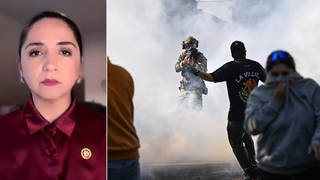
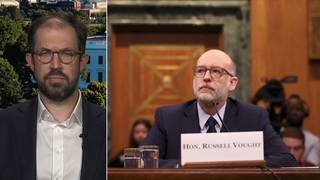
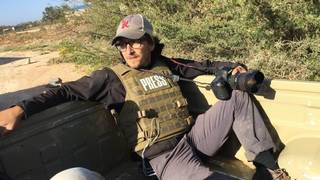
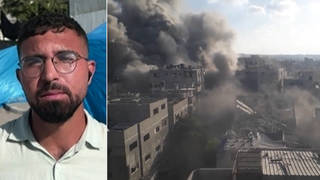





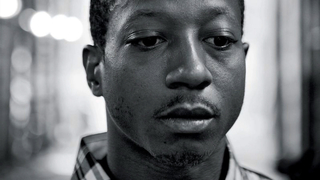
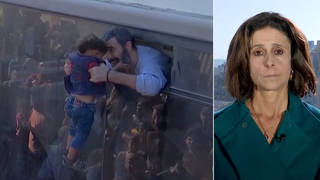
Media Options